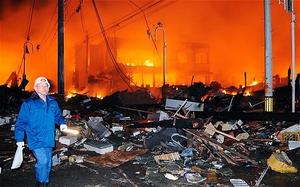CatastrophesThe problems with major disasters
There are three problems with major disasters: small miscalculations of probabilities can have large effects on outcomes when dealing with large events; our reward structures do not encourage spending the time or the money to deal with low-probability disasters; the very complexity of modern life — including our transportation and communication systems, our economy and our social interactions — is directly implicated in the severity of catastrophes; in more complex systems, even small changes or perturbations can have disproportionate and unpredictable effects

Setting priorities amidst utter destruction // Source: allhumanity.org
The past decade witnessed the 9/11 attacks, the tsunami in the Indian Ocean, Hurricane Katrina, the global financial crisis, a global flu pandemic, the earthquake in Haiti, the oil spill in the Gulf of Mexico, and devastating floods in Australia and New Zealand. Now, Japan has been hit with an earthquake, tsunami, and nuclear crisis.
Steve Pearlstein writes in the Washington Post that what all of these have in common is that they are all low-probability, high-impact events – or, as risk modelers call them, the “long-tail” phenomenon (they refer to the far ends of the traditional bell curve of probabilities).
There are three major problems in dealing with major catastrophes. Pearlstein notes that small miscalculations of probabilities can have large effects on outcomes when dealing with long periods of time. We may think of a sailor who sets off on a voyage a few degrees off course. A few miles out, the error is small, but by the time he crosses the ocean, he may find himself hundreds of miles from the intended destination.
It is the same with calculating the best preparations for, and the likely consequences, of a major event: Because of the sheer size of the event, even a tiny miscalculation in what would be required to blunt the worst consequences of the event would result in lethal exposure.
The second problems is that our reward structures do not encourage spending the time or the money to deal with low-probability disasters. The chief executive of Citigroup acknowledged as much when he told a reporter in 2007 that he would lose his job if he gave up profit and market share to shield his bank from the obviously excessive risk-taking that everyone knew was going on. “You can only imagine the outcry from the industry and those Gulf Coast politicians if government regulators back in 2009 had ordered oil companies to spend millions of dollars to have enough boats and booms at the ready to deal with a BP-sized oil spill from deepwater drilling,” Pearlstein writes.
Then there is a third problem. Scholars argue that the very complexity of modern life — including our transportation and communication systems, our economy and our social interactions — is directly implicated in the severity of catastrophes. In more complex systems, even small changes or perturbations can have disproportionate and unpredictable effects. The things that make our systems more efficient also make them more effective in spreading the impact of a catastrophe.
The lesson to be drawn from all this, Pearlstein concludes, is not that we should roll back the clock and return to a simpler and less interconnected existence. “It is, rather, that more attention must be paid to extra risks that come with all the advantages of modern life. There may be a significant cost involved in preventing low-probability disasters, or having sufficient infrastructure to deal with them when they cannot be prevented. But as we are reminded by this week’s events in Japan, that cost is likely to be less than the cost of ignoring those risks and doing nothing at all.”
